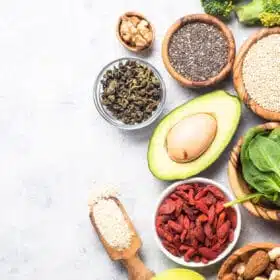If the messages of various lifestyle magazines are to be believed, hardly any other topic occupies the female soul as much as one's own body weight. In the face of skinny models and questionable beauty ideals, it also quickly becomes clear why the fear of gaining weight is so widespread, even among women in training. But instead of leading to a feel-good weight, strict diets often have the opposite effect, which again fuels the fallacy that every single calorie is one too many. However, if you want to succeed in sports and build an athletic body, it's imperative that you approach food from a different perspective. In this article, we'll show you how to gain healthy weight and build an athletic, attractive body in parallel with your workouts.
Overcoming the barrier in the head
Even though many women break out in a sweat at the mere mention of the term calories, it is precisely this unit of account for the calorific value of food that plays a central role in building a healthy body. Unfortunately it corresponds to the reality that the Jojo effect, which experiences in particular Diätveteraninnen again and again, is based on the fact that too little food is supplied and the human body, which is trimmed evolutionarily on efficiency, reacts paradoxically with the storage of depot fat. The first step in building muscle is in the mind, not least because of this fact. Overcome your inner pig dog and become aware of the fact that calories only represent a calorific value, which, moreover, help you to precisely reach your goal. Once you have overcome this mental barrier, you should calculate your basal metabolic rate using the formula: Body Weight x 24 to determine your total metabolic rate. Multiply your basal metabolic rate by the PAL value, which corresponds to your daily activity level, to get the total metabolic rate that you metabolize each day. To gain a little weight in the form of muscle in a healthy way, you should make sure that you do not exceed the calculated total metabolic rate in your daily diet too much, otherwise the proportion of stored body fat in relation to muscle will increase too much. A daily plus of about 200 calories is sufficient in any case to slowly but steadily build up an athletic body.
Overview of PAL values
- 1.1 to 1.2 | predominantly sedentary activity | e.g. elderly people, wheelchair users
- 1.3 to 1.5 | sedentary job with movement activity | e.g. office workers, teachers, students
- 1.6 to 1.7 | sedentary occupation with some movement | e.g. laboratory assistants, assembly line workers
- 1.8 to 1.9 | mainly standing activity | e.g. craftsman, waiter
- 2.0 to 2.4 | hard physical work | e.g. competitive athletes, construction workers
Planning is everything
By far the most effective way to build a healthy body involves not only regular training, but also conscientious planning of the daily diet. It is obvious that the listing of foods and macronutrients is initially associated with some effort, but at the latest when the first successes show, you will realize that a conscious diet can not only be fun, but also produces significantly better results than the hundredth fad diet that shines exclusively by low calorie and monotony. In order to achieve constant success, it is recommended that on non-training days you consume the amount of calories that makes up your total metabolic rate and the additional 200 kilocalories that your body uses to build new tissue structures. On training days, you must again consume the amount of energy in the form of calories burned during the workout in order to maintain a positive energy balance at the end of the day. Once you have set up the plan for yourself, you may be surprised at how much you actually have to eat to gain body weight, but after a while you will notice that, contrary to all the legends spread by various magazines, your body is developing in the desired direction.
Which healthy foods are suitable and which are not?
It's true that the amount of calories is the key to success, but this does not mean that you should neglect the quality of food. To gain weight in a healthy way, the same rules apply to you as to the gentlemen of the guild. Plenty of fruits and vegetables are just as obligatory as lean protein sources consisting of turkey meat, dairy products and fish, as well as complex carbohydrates in the form of pasta, rice, potatoes and cereals. Fats also belong in your diet in any case, in addition to high-quality proteins and carbohydrates. Nuts, seeds and sea fish in particular contain valuable omega-3 and omega-6 fatty acids, which your body needs to maintain a healthy metabolism. In addition, it has recently been scientifically proven that these unsaturated fatty acids inhibit the buildup of depot fat, which benefits your goal. However, you should watch out for hidden granulated sugar, which is not only found in sweets, but also in everyday products such as tomato ketchup. Even if you should avoid refined sugar in any form, you don't have to give up sweet treats, of course, because fruit is still on your menu. Even a piece of dark chocolate and a cappuccino at the ice cream parlor around the corner won't jeopardize your goal of healthy weight gain, as long as you plan your diet conscientiously, which is necessary in any case to reach your goal as quickly and healthily as possible.
The Lean Gain is a high quality weight gainer. The carbohydrate-protein shake is suitable for women who have trouble gaining healthy weight or maintaining the weight they have gained.
Conclusion
Of course, building a strong and healthy body takes a little effort in the form of self-discipline and meticulous planning. But once you realize that calories aren't your enemy, and that you need to give your body enough energy to achieve visible results, you'll find it easier every day, and you'll outshine some of your less disciplined male workout buddies in terms of long-term success.




